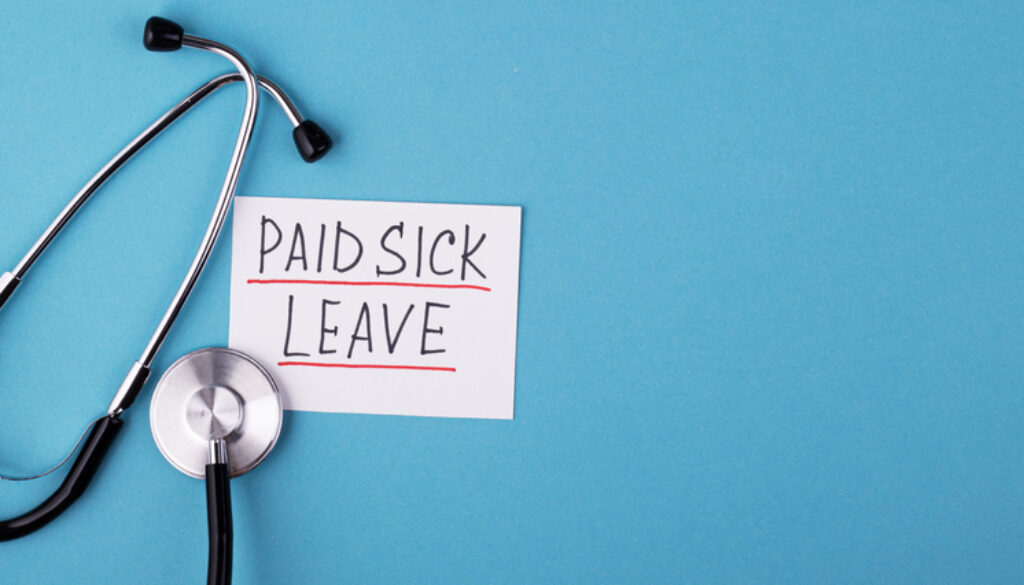How Do Paid Leave Policies Affect Health, Health Equity, and Overall Population Health?
Asiya Validova, Alina Schnake-Mahl, Julia Goodman, Alein Haro-Ramos
Paid Leave: A Pathway to Better Health, Equity, and Economic Stability
As conversations about economic security and health equity intensify, paid leave has emerged as a central issue for families and workers — two key groups in the 2024 election. In this post, we summarize what the evidence tells us about how paid leave drives improved population health and health equity, its impact on workforce participation, the landscape of paid leave policy in the U.S. and globally, and the two presidential candidates’ perspectives on paid leave.
The Current Paid Leave Policy Landscape in the US.
Paid leave includes longer-term paid family and medical leave (PFML), which covers severe health conditions for oneself or a loved one and bonding with a new child; and paid sick leave (PSL), which covers short-term injuries, illnesses, or preventive care.
The federal Family & Medical Leave Act (FMLA) guarantees 12 weeks of unpaid family and medical leave to eligible employees of companies with 50 or more employees. However, the US stands out as one of the only countries in the world without any national PFML or PSL policies. As a result, there are substantial disparities in access to paid leave: for example, 48% of the highest-wage workers have paid family leave access through their employers, compared with 6% of the lowest-wage workers.
Since the early 2000s, state and local jurisdictions have increasingly enacted paid leave policies, covering an increasing proportion of the private and publicly employed worker population. As of 2024, fifteen states, the District of Columbia (DC), and several cities and counties have passed or enacted PSL, and thirteen states and DC have enacted PFML. However, as of 2024, 21% of private sector workers lack paid sick leave, and as of 2023, only 27% of civilian workers had access to paid family leave.
Why Paid Leave Matters
Paid leave — whether for family, medical, or parental reasons — affords workers the time to care for themselves or loved ones without facing devastating financial consequences. This critical safety net allows workers to recover from illness, bond with newborns, or support family members during medical crises. In sum, paid leave policies buffer against the stress and financial strain often accompanying life’s most challenging moments, protecting mental and physical health.
Health Impacts: The link between paid leave and health outcomes is well-documented. Access to paid leave reduces stress, improves mental health, and encourages better recovery from illnesses, particularly for workers with chronic conditions and for new parents. Parents who take paid leave, for example, report lower rates of stress, and their children often experience better developmental outcomes due to parental bonding in the critical early months. Maternity leave also improves birth outcomes, including birth weight and a lower likelihood of preterm birth. Paid leave also promotes preventive care among workers, facilitating routine health checks and vaccinations, ultimately reducing healthcare costs in the long term.
In sum, paid leave policies buffer against the stress and financial strain often accompanying life’s most challenging moments, protecting mental and physical health.
Mechanisms for Health Equity: The lack of paid leave policies disproportionately affects low-income workers, women, and people of color, exacerbating health disparities. Due to occupational segregation, economically marginalized groups, including racially minoritized communities and immigrants, are overrepresented in low-wage jobs. Low-wage jobs are often the least likely to provide paid leave voluntarily, and low-wage workers are the least likely to be able to financially sustain taking time off without pay, leaving them to choose between their health and a paycheck. Without adequate leave, many defer healthcare or rush their recovery, leading to long-term health deterioration. Thus, paid leave serves as a lever for reducing inequities by offering a protective buffer against material hardship, reducing stress and uncertainty regarding finances, and allowing workers to address their health needs — all of which may help improve population health.
Paid Leave and the Labor Market
From an economic perspective, paid leave fosters a more equitable and resilient labor force. Employers often fear that offering paid leave will increase costs and disrupt productivity. However, research shows the opposite: Paid leave reduces turnover, improves job stability, and increases productivity by preventing burnout. Additionally, workers who can take time off for their health or family needs are more likely to remain in the workforce, contributing to economic growth over the long term.
Paid leave also helps mitigate the labor market’s gender inequities. Women are more likely to bear caregiving responsibilities, and without paid leave, they are often forced to reduce hours, leave the workforce, or accept lower-paying, more flexible jobs. Paid family leave policies help level the playing field by allowing all workers, regardless of gender, to care for family members without economic penalty. This fosters greater gender equity in the home and the workplace, offering women a chance to continue career advancement while meeting caregiving needs.
Paid Leave in a Global Context
Could U.S. policymakers learn from the extensive evidence from family policies in other countries, cross-country studies, and global comparisons? After all, paid family, medical, and sick leave mandates are widespread outside the US. Research from high-income countries shows that paid parental leave policies are consistently associated with improvements in maternal and child health outcomes. Increases in weeks of paid leave are associated with reduced infant mortality in 16 European countries and decreases in prenatal, postneonatal, infant, and under-five mortality in 35 OECD countries.
Although such policy responses have been more extensive in Europe, they are spreading outside the global North. In low- and middle-income countries, where national paid leave programs are less generous and more comparable to state paid leave policies in the U.S., paid maternity and paternity leave policies also demonstrate a great potential to reduce infant mortality rates, benefiting women economically by providing job protection and promoting gender equity as well as providing health benefits for mothers and children. One study evaluating paid maternity leave effects on infant and child mortality in 34 countries in Asia and the Pacific between 1991 and 2016 found that national guarantees of paid maternity leave were associated with lower infant and under-five mortality. The Latin American region is another example of introducing and extending the length of paid parental leave policies to address gaps related to parenthood where gender equality in the labor market remains a big challenge. Over the last two decades, most Latin American countries increased the weeks of paid maternity leave which nowadays ranges from the lowest 12 weeks to the highest of 30 weeks in Chile.
These examples are particularly relevant, given a great deal of emphasis placed on reducing infant mortality in the United States, which is the highest among the high-income countries despite the most healthcare spending. Paid parental leave could help address social and health risk factors that contribute to infant mortality and reduce the rates of infant deaths, which is one of the Healthy People objectives.
As population health researchers, we should understand which candidates — from city councilmembers to the president — will work to enact expansive and inclusive paid leave policies.
Connecting Paid Leave to the 2024 Elections
As we approach the 2024 elections in the US, paid leave is (finally) a focal point of policy discussions. The pandemic exposed the urgent need for federal PFML and PSL policies as millions of workers faced caregiving responsibilities with limited or no support. While several states have implemented or expanded their paid leave programs, a growing demand for national standards remains.
This November, three states (Missouri, Alaska, and Nebraska), all with Republican governors and predominantly Republican legislators (the Alaska lower chamber is split between parties), will vote on paid sick leave ballot measures. However, to date, nearly all the states that have enacted paid leave policies have Democratic trifectas (governor and majority in both legislative chambers). In Republican-controlled states, many legislators and governors have not only failed to enact paid family leave, they’ve gone further by preempting (prohibiting cities from enacting) policies to provide these benefits to their constituents. Importantly, these policies do not operate in isolation; they are often enacted along with other reproductive health related policies. In the 25 states that have banned or severely restricted abortion since the Dobbs decision, zero provide paid family leave.
The two major parties have taken dramatically different approaches at the state level, but what does this mean for the upcoming presidential election?
The Harris campaign has pledged to establish federal paid family and medical leave, though the campaign has been short on policy details. Paid sick leave, however, hasn’t been explicitly mentioned as part of the Democratic ticket’s policy agenda.
Trump and his campaign haven’t made any explicit statements supporting or opposing paid family, medical, or sick leave to date, but the vice-presidential debate may be able to give us insight into the ticket’s policy goals. During that debate, the candidates were asked about paid leave policies for new parents and how long employers should be required to pay workers, with the moderator citing Walz’s statement that he would make paid leave a “day one priority”. Walz reasserted his support for federal paid family leave, albeit without providing any detail. Vance asserted that he “thought there was a bipartisan solution.” He then pivoted to discussing cultural barriers to paid leave use and conflating paid leave with funding for childcare.
Where do we go from here?
Candidates and policymakers who champion comprehensive paid leave policies are positioning themselves as advocates for working families, gender equity, and public health. And decades of research from the US and around the globe has shown that paid leave is a critical tool for advancing population health. As population health researchers, we should understand which candidates — from city councilmembers to the president — will work to enact expansive and inclusive paid leave policies. However, we should not be satisfied with the options currently on the table. Taking a global lens to US policies reveals the relative inadequacy of current and proposed paid leave policies, even in the most generous states. For example, most state paid family and medical leave policies cover a maximum of 12 weeks, and just one (Oregon) provides full wage replacement for the lowest wage workers. Compare that to OECD countries, where the average duration of parental leave available is 44 weeks, with additional leave available for medical and caregiving needs in most countries.
As we consider future policy expansions at home, let’s look to our global peers for innovative and equitable ways to support working families, gender equity, and public health.








All comments will be reviewed and posted if substantive and of general interest to IAPHS readers.